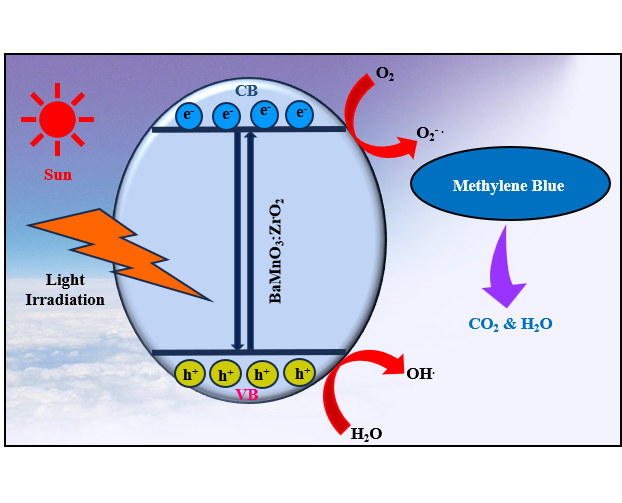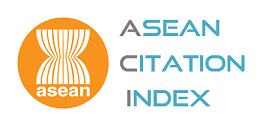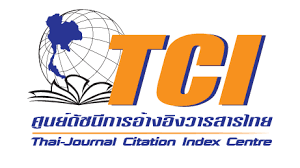Facile synthesis of BaMnO\(_{3}\)-ZrO\(_{2}\) composite: A step towards the photocatalytic degradation of organic dye
DOI:
https://doi.org/10.55713/jmmm.v35i3.2233Keywords:
Methylene blue, Photocatalysis, Photocatalyst, Dye degradationAbstract
Environmental contamination by synthetic dyes, particularly Methylene Blue (MB), presents a significant threat to aquatic ecosystems and human health due to their chemical stability and toxicity. This study investigates the photocatalytic degradation of MB using a BaMnO3:ZrO2 composite synthesized in a 1:2 ratio via a straightforward wet-chemical method. Structural and optical characterizations were performed using X-ray diffraction (XRD), Scanning electron microscopy (SEM), Fourier-transform infrared spectroscopy (FTIR), and Ultraviolet-visible diffuse reflectance spectroscopy (UV-DRS). The composite exhibited a reduced bandgap of 2.88 eV and uniform nanoscale morphology, both favorable for visible-light-driven photocatalysis. Under visible-light irradiation, the catalyst achieved 89% degradation efficiency within 105 min at neutral pH (7.5). These results underscore the synergistic effect of the BaMnO3–ZrO2, which facilitates effective charge separation and reactive species generation. This work highlights the composite’s potential as a sustainable and reusable photocatalyst for wastewater treatment applications.
Downloads
References
H. B. Slama, A. C. Bouket, Z. Pourhassan, F. N. Alenezi, A. Silini, H. C. Sillini, T. Oszako, L. Luptakova, P. Golinska, and L Belbahri, “Diversity of synthetic dyes from textile industries, discharge impacts and treatment methods,” Applied Sciences, vol. 11, no. 14, p. 6255, 2021. DOI: https://doi.org/10.3390/app11146255
M. Yusuf, “Synthetic dyes: A threat to the environment and water ecosystem,” Textiles and Clothing, pp. 11-26, 2019. DOI: https://doi.org/10.1002/9781119526599.ch2
A. Tkaczyk, K. Mitrowska, and A. Posyniak, “Synthetic organic dyes as contaminants of the aquatic environment and their implications for ecosystems: A review,” Science of the Total Environment, vol. 717, p. 137222, 2020. DOI: https://doi.org/10.1016/j.scitotenv.2020.137222
P. O. Oladoye, T. O. Ajiboye, E. O. Omotola, and O. J. Oyewola, “Methylene blue dye: Toxicity and potential elimination technology from wastewater,” Results in Engineering, vol. 16, p. 100678, 2022. DOI: https://doi.org/10.1016/j.rineng.2022.100678
O. A. Yildirim, M. Bahadir, and E. Pehlivan, “Detrimental effects of commonly used textile dyes on the aquatic environment and human health--a review,” Fresenius Environmental Bulletin, vol. 31, pp. 9329-9345, 2022.
S. A. Behera, A. Subhadarshini, S. S. Bhuyan, B. Nanda, and P. G. R. Achary, “PVDF/rGO/CuO nanocomposites: A robust platform for solar-driven tetracycline photodegradation,” Inorganic Chemistry Communications, vol. 160, p. 111995, 2024. DOI: https://doi.org/10.1016/j.inoche.2023.111995
S. A. Behera, A. Amanat, and P. G. R. Achary, “Photocatalytic degradation of ciprofloxacin drug utilizing novel PVDF/ polyaniline/lanthanum strontium manganate@ Ag composites,” Journal of Metals, Materials and Minerals, vol. 34, no. 1, p. 1896, 2024. DOI: https://doi.org/10.55713/jmmm.v34i1.1896
S. Li, K. Rong, X. Wang, C. Shen, F. Yang, and Q. Zhang, “Design of carbon quantum dots/CdS/Ta3N5 S-scheme hetero-junction nanofibers for efficient photocatalytic antibiotic removal,” Acta Physico-Chimica Sinica, vol. 40, no. 12, p. 2403005, 2024. DOI: https://doi.org/10.3866/PKU.WHXB202403005
C. You, C. Wang, M. Cai, Y. Liu, B. Zhu, and S. Li, “Improved photo-carrier transfer by an internal electric field in BiOBr/ Nrich C3N5 3D/2D S-scheme heterojunction for efficiently photocatalytic micropollutant removal,” Acta Physico-Chimica Sinica, vol. 40, no. 11, p. 2407014, 2024. DOI: https://doi.org/10.3866/PKU.WHXB202407014
L. V. Samarasinghe, S. Muthukumaran, and K. Baskaran, “Recent advances in visible light-activated photocatalysts for degradation of dyes: A comprehensive review,” Chemosphere, p. 140818, 2023. DOI: https://doi.org/10.1016/j.chemosphere.2023.140818
G. Saianand, A-I. Gopalan, L. Wang, K. Venkatramanan, V. A. L. Roy, P. Sonar, D-E. Lee, and R. Naidu, “Conducting polymer based visible light photocatalytic composites for pollutant removal: Progress and prospects,” Environmental Technology & Innovation, vol. 28, p. 102698, 2022. DOI: https://doi.org/10.1016/j.eti.2022.102698
V. Torregrosa-Rivero, M.-S. Sánchez-Adsuar, and M.-J. Illán-Gómez, “Improving the performance of BaMnO3 perovskite as soot oxidation catalyst using carbon black during sol-gel synthesis,” Nanomaterials, vol. 12, no. 2, p. 219, 2022. DOI: https://doi.org/10.3390/nano12020219
V. Torregrosa-Rivero, M.-S. Sanchez-Adsuar, and M.-J. Illan-Gomez, “Analyzing the role of copper in the soot oxidation performance of BaMnO3-perovskite-based catalyst obtained by modified sol-gel synthesis,” Fuel, vol. 328, p. 125258, 2022. DOI: https://doi.org/10.1016/j.fuel.2022.125258
K. Hayat, M. J. Iqbal, K. Rasool, and Y. Iqbal, “Device fabrication and dc electrical transport properties of barium manganite nanofibers (BMO-NFs),” Chemical Physics Letters, vol. 616, pp. 126-130, 2014. DOI: https://doi.org/10.1016/j.cplett.2014.10.046
R. Ao, L. Ma Z. Guo, J. Yang, L. Mu, J. Yang, and Y. Wei, “NO oxidation performance and kinetics analysis of BaMO 3 (M= Mn, Co) perovskite catalysts,” Environmental Science and Pollution Research, vol. 28, no. 6, pp. 6929-6940, 2021. DOI: https://doi.org/10.1007/s11356-020-10993-9
N. Terenti, E. Me;nic, V. Fruth, N. Nedelko, P. Aleshkevych, S. Lewinska, A. Slawska-Waniewska, V. Ch. Kravtsov, A. Lazarescu, and V. Lozan, “Synthesis and microstructure of BaMnO3 oxide obtained from coordination precursor,” Journal of Solid State Chemistry, vol. 324, p. 124108, 2023. DOI: https://doi.org/10.1016/j.jssc.2023.124108
A. Kumari, K. Kumari, F. Ahmed, A. Alshoaibi, P. A. Alvi, S. Dalela, M. M. Ahmad, R. N. Aljawfi, P. Dua, A. Vij, and S. Kumar, “Influence of Sm doping on structural, ferroelectric, electrical, optical and magnetic properties of BaTiO3,” Vacuum, vol. 184, p. 109872, 2021. DOI: https://doi.org/10.1016/j.vacuum.2020.109872
K. Hayat, M. A. Rafiq, and M. M. Hasan, “Synthesis and optimization of barium manganate nanofibers by electrospinning,” Ceramics International, vol. 38, no. 2, pp. 1441-1445, 2012. DOI: https://doi.org/10.1016/j.ceramint.2011.09.026
N. C. Horti, M. D. Kamatagi, S. K. Nataraj, M. N. Wari, and S. R. Inamdar, “Structural and optical properties of zirconium oxide (ZrO2) nanoparticles: Effect of calcination temperature,” Nano Express, vol. 1, no. 1, p. 10022, 2020. DOI: https://doi.org/10.1088/2632-959X/ab8684
S. A. Behera, D. Khatua, R. K. Singh, R. N. P. Choudhary, and P. G. R. Achary, “Temperature-dependent electrical and dielectric characteristics of lead germanate Pb5Ge1.5Sn1.5O11,” Inorganic Chemistry Communications, vol. 163, p. 112370, 2024. DOI: https://doi.org/10.1016/j.inoche.2024.112370
T. N. Stanislavchuk, A. P. Litvinchuk, H. Rongwei, J. Y. Hun, J. S. Dae, S.-W. Cheong, and A. A. Sirenko, “Optical properties, lattice dynamics, and structural phase transition in hexagonal 2H-BaMnO3 single crystals,” Physical Review B, vol. 92, no. 13, p. 134308, 2015. DOI: https://doi.org/10.1103/PhysRevB.92.134308
D. Prakashbabu, R. H. Krishna, B. M. Nagabhushana, H. Nagabhushana, C. Shivakumara, R. P. S. Chakradar, H. B. Ramalingam, S. C. Sharma, and R. Chandramohan, “Low temperature synthesis of pure cubic ZrO2 nanopowder: Structural and luminescence studies,” Spectrochimica Acta Part A: Molecular and Biomolecular Spectroscopy, vol. 122, pp. 216-222, 2014. DOI: https://doi.org/10.1016/j.saa.2013.11.043
P. L. Krapivsky, and E. Ben-Naim, “Collective properties of adsorption--desorption processes,” Journal of Chemical Physics, vol. 100, no. 9, pp. 6778-6782, 1994. DOI: https://doi.org/10.1063/1.467037
S. Li, C. You, K. Rong, C. Zhuang, X. Chen, and B. Zhang, “Chemically bonded Mn0. 5Cd0.5S/BiOBr S-scheme photo-catalyst with rich oxygen vacancies for improved photocatalytic decontamination performance,” Advanced Powder Materials, vol. 3, no. 3, p. 100183, 2024. DOI: https://doi.org/10.1016/j.apmate.2024.100183
C. Shen, X. Li, B. Xue, D. Feng, Y. Liu, F. Yang, M. Zhang, and S. Li, “Surface plasmon effect combined with S-scheme charge migration in flower-like Ag/Ag6Si2O7/Bi12O17Cl2 enables efficient photocatalytic antibiotic degradation,” Applied Surface Science, vol. 679, p. 161303, 2025. DOI: https://doi.org/10.1016/j.apsusc.2024.161303
J. Abdi, M. Yahyanezhad, S. Sakhaie, M. Vossoughi, and I. Alemzadeh, “Synthesis of porous TiO2/ZrO2 photocatalyst derived from zirconium metal organic framework for degradation of organic pollutants under visible light irradiation,” Journal of Environmental Chemical Engineering, vol. 7, no. 3, p. 103096, 2019. DOI: https://doi.org/10.1016/j.jece.2019.103096
M. R. Alotaibi, and M. H. H. Mahmoud, “Promptness of tetracycline pollutant degradation via CuCo2O4@ZrO2 nano-composites photocatalyst,” Optical Materials (Amst)., vol. 126, p. 112200, 2022. DOI: https://doi.org/10.1016/j.optmat.2022.112200
M. Tanzifi, M. Jahanshahi, M. Peyravi, and S. Khalili, “A morphological decoration of g-C3N4/ZrO2 heterojunctions as a visible light activated photocatalyst for degradation of various organic pollutants,” Journal of Environmental Chemical Engineering, vol. 10, no. 6, p. 108600, 2022. DOI: https://doi.org/10.1016/j.jece.2022.108600
C. F. Carbuloni, J. E. Savoia, J. S. P. Santos, C. A. A. Pereira, R. G. Marques, V. A. S. Ribeiro, and A. M. Ferrari, “Degradation of metformin in water by TiO2-ZrO2 photocatalysis,” Journal of Environmental Management, vol. 262, p. 110347, 2020. DOI: https://doi.org/10.1016/j.jenvman.2020.110347
W. Du, X. Wang, H. Li, D. Ma, S. Hou, J. Zhang, X. Qian, and H. Pang, “ZrO2/Dy2O3 solid solution nano-materials: tunable composition, visible light-responsive photocatalytic activities and reaction mechanism,” Journal of the American Ceramic Society, vol. 96, no. 9, pp. 2979-2986, 2013. DOI: https://doi.org/10.1111/jace.12414
Q. Zhou, L. Li, X. Zhang, H. Yang, Y. Cheng, H. Che, L. Wang, and Y. Cao, “Construction of heterojunction and homojunction to improve the photocatalytic performance of ZnO quantum dots sensitization three-dimensional ordered hollow sphere ZrO2-TiO2 arrays,” International Journal of Hydrogen Energy, vol. 45, no. 56, pp. 31812-31824, 2020. DOI: https://doi.org/10.1016/j.ijhydene.2020.08.157
W. Du, Z. Zhu, X. Zhang, D. Wang, D. Liu, X. Qian, and J. Du, “RE/ZrO2 (RE= Sm, Eu) composite oxide nano-materials: Synthesis and applications in photocatalysis,” Materials Research Bulletin, vol. 48, no. 10, pp. 3735-3742, 2013. DOI: https://doi.org/10.1016/j.materresbull.2013.05.114
A. Yaghoubi, A. Ramazani, and S. Taghavi Fardood, “Synthesis of Al2O3/ZrO2 nanocomposite and the study of its effects on photocatalytic degradation of reactive blue 222 and reactive yellow 145 dyes,” ChemistrySelect, vol. 5, no. 32, pp. 9966-9973, 2020. DOI: https://doi.org/10.1002/slct.202002578
S. P. Keerthana, R. Yuvakkumar, P. S. Kumar, G. Ravi, and D. Velauthapillai, “Nd doped ZrO2 photocatalyst for organic pollutants degradation in wastewater,” Environmental Technology & Innovation, vol. 28, p. 102851, 2022. DOI: https://doi.org/10.1016/j.eti.2022.102851
N. P. de Moraes, C. A. S. H. de Azeredo, L. A. Bacetto, M. L. C. P. da Silva, and L. A. Rodrigues, “The effect of C-doping on the properties and photocatalytic activity of ZrO2 prepared via sol-gel route,” Optik (Stuttgart), vol. 165, pp. 302-309, 2018. DOI: https://doi.org/10.1016/j.ijleo.2018.03.133
C. V. Reddy, I. N. Reddy, K. Ravindranadh, K. R. Reddy, D. Kim, and J. Shim, “Ni-dopant concentration effect of ZrO2 photocatalyst on photoelectrochemical water splitting and efficient removal of toxic organic pollutants,” Separation and Purification Technology., vol. 252, p. 117352, 2020. DOI: https://doi.org/10.1016/j.seppur.2020.117352

Downloads
Published
How to Cite
License
Copyright (c) 2025 Journal of Metals, Materials and Minerals

This work is licensed under a Creative Commons Attribution-NonCommercial-NoDerivatives 4.0 International License.
Authors who publish in this journal agree to the following terms:
- Authors retain copyright and grant the journal right of first publication with the work simultaneously licensed under a Creative Commons Attribution License that allows others to share the work with an acknowledgment of the work's authorship and initial publication in this journal.
- Authors are able to enter into separate, additional contractual arrangements for the non-exclusive distribution of the journal's published version of the work (e.g., post it to an institutional repository or publish it in a book), with an acknowledgment of its initial publication in this journal.












